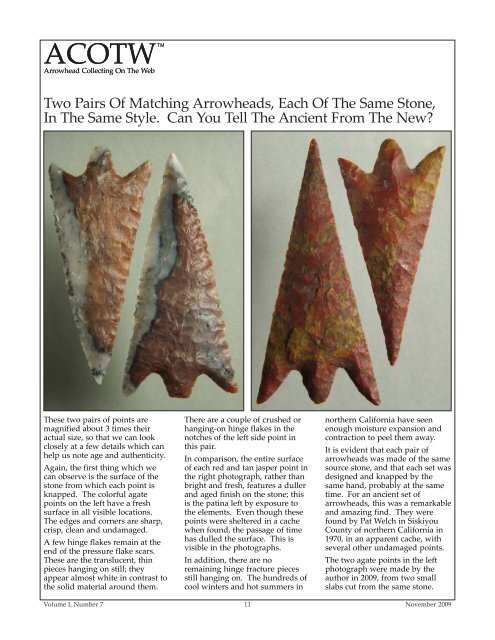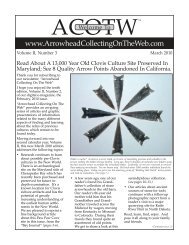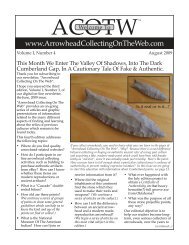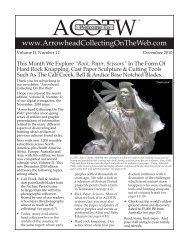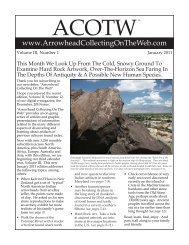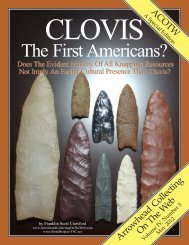STOP! - Arrowhead Collecting On The Web
STOP! - Arrowhead Collecting On The Web
STOP! - Arrowhead Collecting On The Web
You also want an ePaper? Increase the reach of your titles
YUMPU automatically turns print PDFs into web optimized ePapers that Google loves.
ACOTW<br />
<strong>Arrowhead</strong> <strong>Collecting</strong> <strong>On</strong> <strong>The</strong> <strong>Web</strong><br />
<strong>Arrowhead</strong> <strong>Collecting</strong> <strong>On</strong> <strong>The</strong> <strong>Web</strong><br />
TM<br />
Two Pairs Of Matching <strong>Arrowhead</strong>s, Each Of <strong>The</strong> Same Stone,<br />
In <strong>The</strong> Same Style. Can You Tell <strong>The</strong> Ancient From <strong>The</strong> New?<br />
<strong>The</strong>se two pairs of points are<br />
magnified about 3 times their<br />
actual size, so that we can look<br />
closely at a few details which can<br />
help us note age and authenticity.<br />
Again, the first thing which we<br />
can observe is the surface of the<br />
stone from which each point is<br />
knapped. <strong>The</strong> colorful agate<br />
points on the left have a fresh<br />
surface in all visible locations.<br />
<strong>The</strong> edges and corners are sharp,<br />
crisp, clean and undamaged.<br />
A few hinge flakes remain at the<br />
end of the pressure flake scars.<br />
<strong>The</strong>se are the translucent, thin<br />
pieces hanging on still; they<br />
appear almost white in contrast to<br />
the solid material around them.<br />
<strong>The</strong>re are a couple of crushed or<br />
hanging-on hinge flakes in the<br />
notches of the left side point in<br />
this pair.<br />
In comparison, the entire surface<br />
of each red and tan jasper point in<br />
the right photograph, rather than<br />
bright and fresh, features a duller<br />
and aged finish on the stone; this<br />
is the patina left by exposure to<br />
the elements. Even though these<br />
points were sheltered in a cache<br />
when found, the passage of time<br />
has dulled the surface. This is<br />
visible in the photographs.<br />
In addition, there are no<br />
remaining hinge fracture pieces<br />
still hanging on. <strong>The</strong> hundreds of<br />
cool winters and hot summers in<br />
northern California have seen<br />
enough moisture expansion and<br />
contraction to peel them away.<br />
It is evident that each pair of<br />
arrowheads was made of the same<br />
source stone, and that each set was<br />
designed and knapped by the<br />
same hand, probably at the same<br />
time. For an ancient set of<br />
arrowheads, this was a remarkable<br />
and amazing find. <strong>The</strong>y were<br />
found by Pat Welch in Siskiyou<br />
County of northern California in<br />
1970, in an apparent cache, with<br />
several other undamaged points.<br />
<strong>The</strong> two agate points in the left<br />
photograph were made by the<br />
author in 2009, from two small<br />
slabs cut from the same stone.<br />
Volume I, Number 7 11<br />
November 2009


